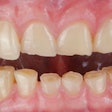
Nearly half of patients who sought root canal treatment for a painful tooth had temporomandibular joint disorders (TMDs), according to a study published on April 6 in the Journal of Oral Rehabilitation. Furthermore, TMDs were partly or solely the cause of the pain in 25% of patients.
The prevalence of TMDs were correlated with more severe symptoms and signs of tooth pain and psychological factors. It is believed to be the first study to assess the prevalence of TMDs using validated TMD diagnostic criteria among patients with a history of tooth pain seeking endodontic treatment, the authors wrote.
“High comorbidity of TMD and endodontic pain warrants routine screening for TMD in patients with [a] history of toothache regardless of the presence of obvious endodontic pathosis,” wrote the authors, led by Dr. Iryna Hryvenko Daline of the University of North Carolina at Chapel Hill.
To better understand the role of TMD pain in endodontic patients, 100 people participated in a cross-sectional study. The participants included 63 women and 37 men who experienced tooth pain 30 days prior to attending a university dental clinic for nonsurgical endodontic treatment or retreatment.
Before root canal treatment, patients completed questionnaires, and a board-certified orofacial pain specialist/endodontic resident diagnosed TMDs using published diagnostic criteria for TMD. Regression models were then used to estimate prevalence ratios to quantify links with patient characteristics, according to the study.
Among the participants, the prevalence of TMDs was 54%. In 26% of patients, TMD pain was unrelated to endodontic pain. In 20% of enrolled patients, TMDs contributed to patients’ chief pain complaint, and the sole source of pain was TMD in 8% of patients, the authors wrote.
Additionally, factors associated with TMD prevalence included the following:
- Moderate or severe pain intensity
- Pain occurring daily or nearly daily
- Pain in more than one tooth
- Tenderness to palpation
- Diagnosis of symptomatic apical periodontitis
- Pain medication use
- Moderate-to-severe psychological distress and high perceived stress
However, the study had limitations, including the lack of follow-up after root canal treatment to assess the persistence, progression, or resolution of TMD after the procedure, the authors wrote.
Nevertheless, the findings reveal a dilemma that comes with endodontic pain management. Patients with more severe symptoms are the very ones who are most likely to have a TMD.
However, the severity of those symptoms may pressure patients and clinicians toward an endodontic intervention that won’t affect the TMD pain. Therefore, dentists and endodontists should collaborate more with orofacial pain specialists and assess patients for TMD, the authors wrote.
“The high frequency of TMD comorbidity warrants consideration in [the] management of endodontic patients with [a] history of toothache,” Daline and colleagues concluded.




















